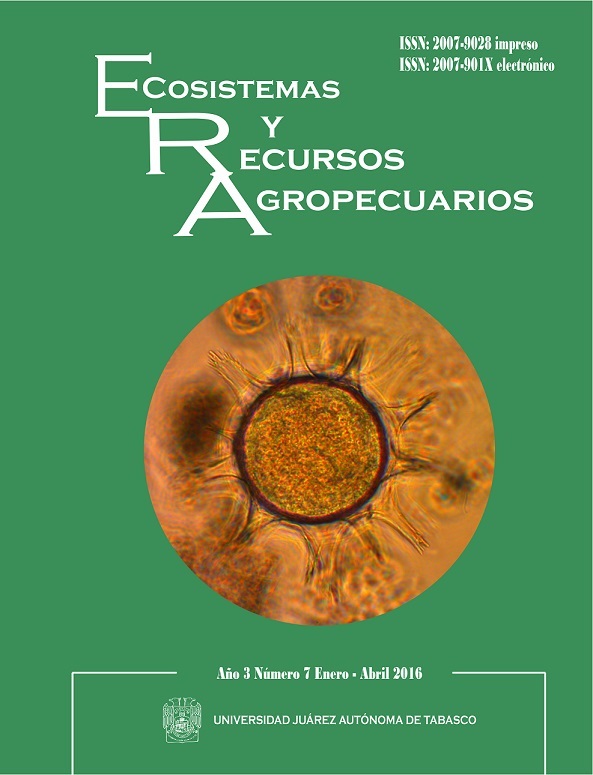ÍNDICES DE SELECCIÓN PARA EL MEJORAMIENTO PRODUCTIVO EN BOVINOS SUIZO EUROPEO EN MÉXICO
DOI:
https://doi.org/10.19136/era.a3n7.168Keywords:
Crecimiento, índices de selección, reproducción, Suizo Europeo, valor económico relativoAbstract
Se derivaron índices de selección para mejorar la producción de carne en bovinos Suizo Europeo con- siderando el peso al nacer (PN), al destete ajustado a 240 d (PD240) y al año de edad, la edad al primer parto (EPP) e intervalo entre partos (IP); se derivaron valores económicos relativos y parámetros genéticos. El modelo animal incluyó los efectos de grupo contemporáneo, aditivo directo, aditivo materno, ambiental permanente y el error; además de la covariable edad de la vaca al parto. Se construyeron 15 índices de selección con restricción en el cambio genético, peso al nacimiento, edad al primer parto o ambos, y otros sin restricción, usando los diferentes grupos de valores económicos calculados. Con el primer grupo de valores económicos, la exactitud en los índices de selección sin restricción varió de 0.342 a 0.464, y con restricción de 0.192 a 0.717. En tanto que con el segundo grupo de valores económicos, la exactitud en los índices sin restricción variaron de 0.516 a 0.602, y con restricción de 0.351 a 0.635. No se observó un deterioro genético de las características de reproducción, aunque no sean incluidas en el criterio de selección. Las características de reproducción parecen ser de importancia secundaria en la selección de bovinos de carne, después de las características de crecimiento.
Downloads
References
Barwick SA, Henzel AL, Goddard ME (1995) Beef breeding for cow fertility: when is it important? Proc. Aust. Assoc. Anim. Breed. Genet. 11:443-446.
Boldman KG, Kriese LA, Van Vleck LD, Van Tassel CP, Kachman SD (1995) A manual for use of MTDFREML. A set of programs to obtain estimates of variances and covariances (DRAFT). U.S. Department of Agriculture, Agriculture Research Service, Lincoln, NE.
Brascamp EW (1984) Selection índices with constraints. Anim Breed Abst 52, 645-654.
Cameron ND (1997) Selection indices and prediction of genetic merit in animal breeding. Roslin Institute, Edinburgh, U. K., CAB International, P: 91.
Cunningham EP, Moen RA, and Gjedrem T (1970) Restriction of selection indexes. Biometrics 26:67–74.
Dickerson GE, Kϋnzi N, Cundiff LV, Koch RM, Arthaud VH, Gregory KE (1974) Selection criteria for efficient beef production. J Anim Sci., 39, 659-673.
Falconer DS, and Mackay TFC (1996) Introducción a la genética cuantitativa. 4th ed. Acribia, S.A. Zaragoza, España.
Graser H, Nitter UG, Barwick SA (1994) Evaluation of advanced industry breeding schemes for Australian beef cattle. II. Selection on combinations of growth, reproduction and carcase criteria. Aust. J. Agric. Res. 45 1657-1669.
Hazel LN (1943) The genetic basis for constructing selection indexes. Genetics 28, 476-490.
Johnston DJ, and Bunter KL (1996) Days to calving in Angus cattle: genetic and environmental effects, and covariances with other traits. Livest. Prod. Sci. 45 13-22.
Kempthorne O, and Nordskog AE (1959) Restricted selection índices. Biometrics 15:10-19.
MacNeil MD (2003) Genetic evaluation of an index of birth weight and yearling weight to improve efficiency of beef production. J. Anim. Sci., 81, 2425–2433.
MacNeil MD, and Newman S (1994) Selection indices for Canadian beef production using specialized sire and dam lines. Can. J. Anim. Sci. 74: 419424.
Meyer K, Hammond K, Parnell PF, Mackinnon MJ, Silvarajasingam S (1990) Estimates of heritability and repeatability for reproductive traits in Australian beef cattle. Livest. Prod. Sci.
Morris CA,. and Cullenn G (1995) Genetic studies of “days to calving” in beef cattle. Proc. Aust. Assoc. Anim. Breed. Genet. 11: 350-355.
Phocas F, Renand G, Menissier F (1998) Results from a bio-economic model for French beef cattle breeding objectives. In: Proc. 6th. World Congress on Genetics Applied to Livestock Production, 11-16 January 1998, Armidale, Australia, Vol. 25, pp. 343-346.
Ponzoni RW, and Newman S (1989) Developing breeding objectives for Australian beef cattle production. Anim. Prod. 49:35-47.
Roso VM, and Schenkel RS (2006) AMC – A computer program to assess the degree of connectedness among contemporary groups. In: Proceedings of the 8th World Congress on Genetics Applied to Livestock Production, August, 13 to 18, Belo Horizonte, Brazil. Communication no. 27-26.
Sharma A, and Basu SB (1986) Incorporation of profit variables for the maximization of genetic gain. Indian Journal Dairy Science 39:35.
Urioste JI, Ponzoni RW, Aguirrezabal M, Rovere G, Saavedra D (1998) Breeding objectives for pasture-fed Uruguayan beef cattle. J. Anim. Breed. Genet. 115:357-373.
Downloads
Published
Issue
Section
License
Aviso de copyright
Los autores que se envían a esta revista aceptan los siguientes términos:
una. Los autores conservan los derechos de autor y garantizan a la revista el derecho a ser la primera publicación del trabajo con una licencia de atribución de Creative Commons que permite a otros compartir el trabajo con un reconocimiento de la autoría del trabajo y la publicación inicial en esta revista.
B. Los autores pueden establecer acuerdos complementarios separados para la distribución no exclusiva de la versión del trabajo publicado en la revista (por ejemplo, en un repositorio institucional o publicarlo en un libro), con un reconocimiento de su publicación inicial en esta revista.
C. Se permite y se anima a los autores a difundir su trabajo electrónicamente (por ejemplo, en repositorios institucionales o en su propio sitio web) antes y durante el proceso de envío, ya que puede conducir a intercambios productivos, así como a una cita más temprana y más extensa del trabajo publicado. (Consulte El efecto del acceso abierto).

